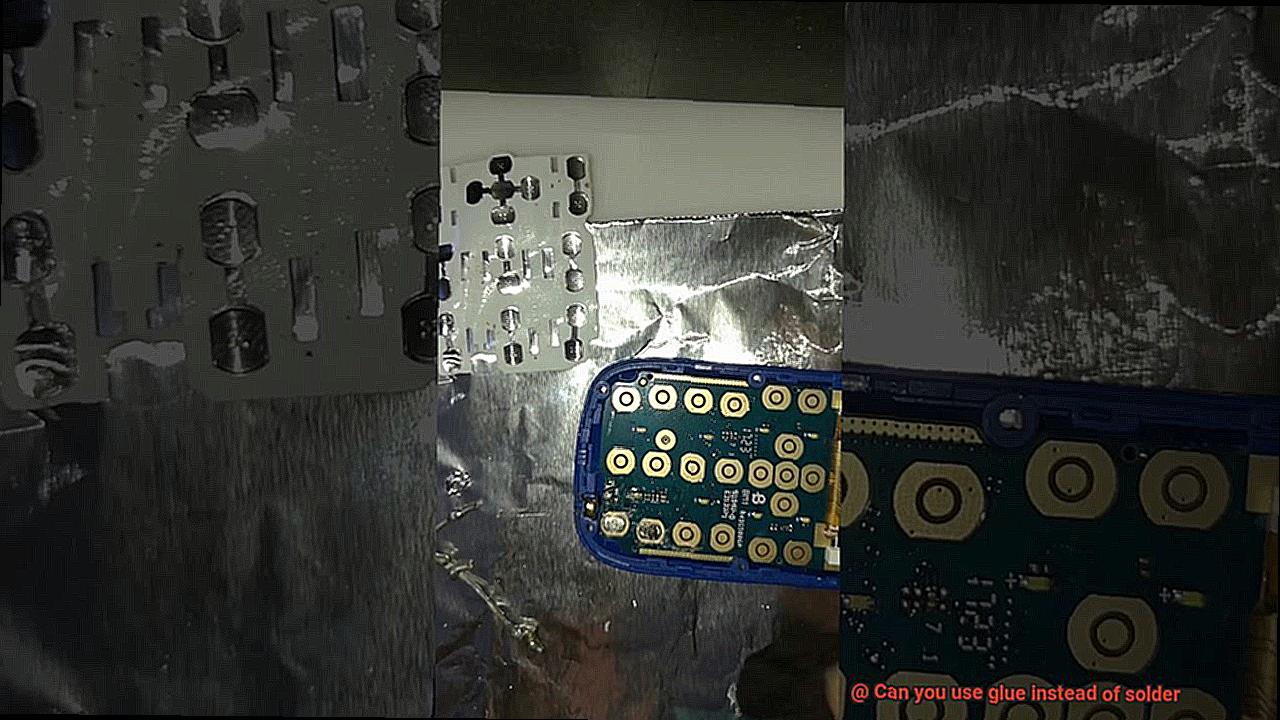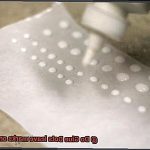When it comes to DIY projects and quick fixes, soldering has always been seen as a crucial skill. Whether you’re tinkering with electronics, creating beautiful jewelry, or just trying to fix a broken appliance, soldering is often the go-to method for joining metals together. But what if there was an alternative that offered simplicity and convenience? Enter glue – the adhesive wonder that has revolutionized various industries.
The big question is: Can glue really replace the reliable bond of solder? Can it provide the durability and conductivity needed for electronic connections? In this blog post, we’re embarking on an investigative journey to uncover the truth behind this intriguing query.
Throughout history, soldering has been the preferred method for joining metallic components. By melting a low-temperature metal alloy, like lead or tin, solder creates a strong and conductive bond. This technique has proven itself in countless applications, from delicate microelectronics to heavy-duty metalwork.
But as technology advances and new adhesives hit the market, using glue as a viable alternative to soldering has become a possibility. With various types of adhesives available – from epoxy to cyanoacrylate – it’s only natural to explore their potential benefits and limitations.
While glue undeniably offers several advantages such as ease of use, environmental friendliness, and cost-effectiveness, concerns about durability, conductivity, and heat resistance may cast doubts on its suitability as a substitute for soldering. That’s why it’s crucial to dig deeper into the strengths and weaknesses of glue in order to make informed decisions in our DIY endeavors.
Throughout this blog post, we’ll analyze key aspects that determine whether glue can truly compete with soldering. We’ll delve into the nature of adhesive bonding, discuss prominent types of glue, examine their electrical conductivity properties, and unravel real-life scenarios where using glue instead of solder may be a viable option.
So, join us on this journey as we navigate the reliability, longevity, and compatibility of glue as a potential substitute for soldering. By uncovering the truth behind this age-old debate, we hope to equip you with the knowledge needed to make informed decisions and master your future DIY aspirations.
What is Soldering?
Contents
Intricate electronic devices, sleek jewelry pieces, and even your home’s plumbing system all rely on the art of soldering. Soldering is a technique used in electronics and metalwork to join two or more pieces of metal together, creating a strong and permanent bond.
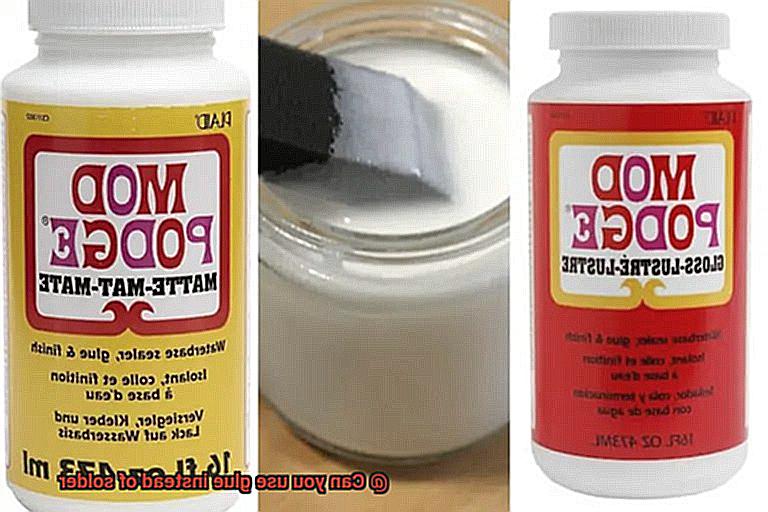
At its core, soldering involves melting a filler metal, known as solder, and meticulously applying it to the joint area. This molten solder then cools and hardens, effectively fusing the metals together. But don’t be fooled by its seemingly simple process – successful soldering requires careful preparation and precise technique.
To ensure optimal adhesion between the metals, the surfaces to be soldered must be meticulously cleaned. This removes any contaminants like dirt, grease, or oxidation. Flux, a chemical compound, is often applied to the joint area to remove oxides and promote the flow of solder by reducing surface tension.
Once the preparation is complete, a soldering iron or soldering gun provides the necessary heat. These tools have a heating element that reaches temperatures sufficient to melt the solder without damaging surrounding materials. Carefully bringing the heated iron into contact with the joint allows the heat to transfer to the metals.
As the metals reach the appropriate temperature, solder is applied at the junction point. Capillary action draws the molten solder into the gap between the metals, forming a strong bond. As it cools down, the solder solidifies and creates a connection that can withstand mechanical stress and temperature changes.
Soldering offers advantages beyond its strong bond. One notable advantage is its ability to provide good electrical conductivity. Most solders contain metals like tin and lead that conduct electricity well. This makes soldered joints ideal for various electronic applications where uninterrupted current flow is crucial.
In addition to its electrical properties, soldering offers precise control over joint quality. The amount of solder used can be carefully controlled, resulting in neat and aesthetically pleasing joints. This makes soldering an excellent choice for applications that require both functionality and visual appeal.
When considering alternatives like glue for joining metals, it’s important to note the limitations. Glue lacks the necessary properties for reliable and durable metal bonding. Soldered joints provide uninterrupted electrical current flow, making them essential in many electronic applications. Additionally, soldered joints can withstand high temperatures without losing their integrity, while glue may not have the same level of heat resistance.
What is Glue?
It’s the unsung hero of the crafting world, the invisible force that holds our projects together. But have you ever paused to ponder what exactly glue is and how it works its magic?
At its core, glue is an adhesive – a substance that bonds materials together. It’s like a superhero, swooping in to save the day by creating a strong connection between two surfaces. But what gives glue its sticky superpowers?
Glue can be made from a variety of ingredients, with three main types: natural, synthetic, and plant-based. Natural glues are derived from animal bones, while synthetic glues are composed of polymers. Plant-based glues, on the other hand, are derived from substances such as starch or cellulose.
Now that we know what glue is made of, let’s dive into its different types. Wood glue is perfect for woodworking projects because it forms a strong bond that can withstand the test of time. Super glue lives up to its name – incredibly strong and fast-drying, it’s ideal for quick fixes. Fabric glue is specially formulated to adhere to fabrics without damaging them, making it great for sewing projects or repairing clothes.
Epoxy glue is known for its versatility and strength. It can bond a wide range of materials, including metal, glass, ceramics, and plastics. And who could forget about hot glue? This high-temperature adhesive is perfect for crafts and DIY projects because it dries quickly and provides a secure bond.

But how does glue actually work its magic? When you apply glue to a surface, it seeps into the tiny pores and crevices of the material. As it dries, the adhesive molecules form bonds with the molecules of the surface material, creating a strong connection. The strength of the bond depends on various factors: the type of glue used, the nature of the materials being bonded, and even the application method.
Glue isn’t just for sticking things together; it can also be used to seal gaps or fill cracks in materials. This versatility makes it a valuable tool in construction, crafting, and repairs.
However, it’s important to note that glue may not always be a suitable substitute for soldering. Soldering involves melting a metal alloy onto surfaces to create a strong and conductive bond. Glue, on the other hand, relies on adhesion rather than fusion and may not provide the same level of strength or conductivity as solder.
Advantages of Soldering
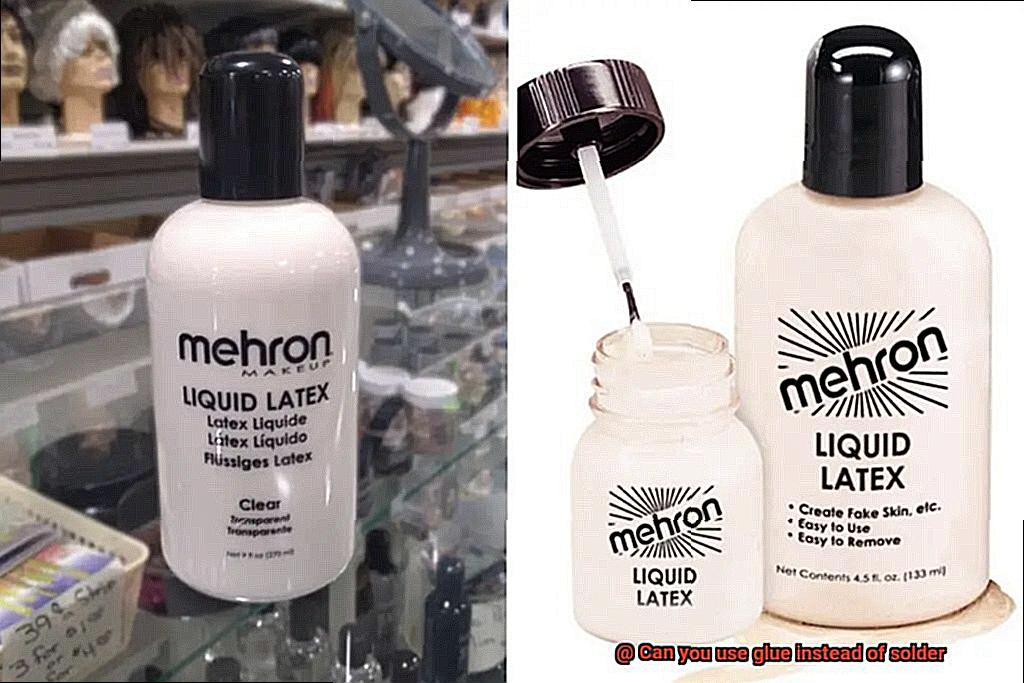
When it comes to creating strong and reliable connections between components, soldering is the preferred choice over glue. Soldering involves melting a metal alloy to form a secure bond, offering numerous advantages that make it ideal for various applications. In this article, we will explore the advantages of soldering and why it is the go-to method for creating strong, reliable, and long-lasting connections.
Advantage 1: Strong and Reliable Bond
Soldering creates a bond that is as solid as steel. The melted metal alloy, usually composed of tin and lead, forms a permanent joint between components. This bond is not easily broken, providing a secure connection that can withstand vibrations and mechanical stress. Whether it’s holding delicate electronic components together or joining heavy-duty metal parts, soldering ensures a bond that can withstand the test of time.
Advantage 2: Electrical Conductivity
One of the significant advantages of soldering is its ability to create an electrically conductive connection. The molten solder fills in any gaps between the components being joined, resulting in a solid electrical pathway. This makes soldering ideal for electronic applications where conductivity is crucial. From circuit boards to electrical wiring, soldering ensures seamless flow of electricity, minimizing resistance and maximizing performance.
Advantage 3: Heat Resistance
Soldered joints have the resilience of a phoenix in a scorching inferno. The metal alloy used in soldering has a high melting point, allowing it to withstand elevated temperatures without degrading or losing its bond strength. This heat resistance is particularly beneficial in applications where the joined components may be subject to extreme temperatures or thermal stress. Soldered connections remain steadfast even in the face of fiery challenges.
Advantage 4: Low Electrical Resistance
Unlike glue that may introduce resistance like a roadblock on the highway, soldered connections offer low electrical resistance. This ensures minimal loss of electrical current between connected components, making soldering essential in electronic circuitry. The seamless flow of electricity through soldered joints guarantees optimal performance and efficiency.
Advantage 5: Compact and Versatile
Soldering is the master of precision and adaptability. It allows for compact and precise connections between components, even in the tightest of spaces. The small size of soldered joints makes them suitable for applications with limited space or intricate designs. Additionally, soldering can be used on a wide range of materials, including metals, ceramics, and plastics, making it a versatile joining method. It’s the go-to choice for intricate electronic devices and robust industrial machinery alike.
Disadvantages of Using Glue Instead of Solder
In the world of electronic component joining, soldering has long reigned as the tried and true method for creating strong, reliable connections. However, some may question if glue could serve as a viable alternative. This article aims to explore the disadvantages of using glue instead of solder in electronic applications. So, let’s delve into the intricate details and reveal the truth behind this sticky debate.

Weaker Bonds:
Glue, while capable of bonding materials together, simply cannot match the strength of solder. Solder creates a permanent bond by melting and flowing into the joint, resulting in a secure electrical and mechanical connection. Conversely, glue relies on adhesion, which may weaken over time or fail altogether. When robust connections are crucial for electronic components, relying on glue is an inferior choice.
Limited Conductivity:
Electrical circuits thrive on uninterrupted current flow. Solder, composed of conductive metals like tin and lead, ensures efficient conductivity. In contrast, glue is an insulator and impedes the necessary flow of electricity. This limitation can hinder circuit functionality and compromise the performance of electronic components. To guarantee optimal electrical conductivity, solder is the go-to option.
Repairs and Modifications:
The flexibility offered by soldering when it comes to repairs or modifications cannot be overstated. Solder joints can be heated and reworked without damaging the components or circuit board, allowing for easy changes or fixes. Glue, however, forms a formidable bond that is difficult to undo or modify without causing damage. This lack of malleability restricts future adjustments and makes glue an impractical choice for electronic repairs.
Heat Sensitivity:
Considering that electronic devices generate heat during operation, selecting a joining method with high heat resistance is essential. Unfortunately, glue can melt or lose its adhesive properties when exposed to high temperatures, posing a potential risk to device functionality. In stark contrast, solder has a higher melting point and can withstand elevated temperatures without compromising the integrity of the joint. In terms of heat resistance, solder emerges as the clear winner.
Compatibility Challenges:
Glue may struggle to effectively adhere to all the materials commonly used in electronic devices. Certain types of plastics, metals, or other materials may pose compatibility issues, limiting the reliability and effectiveness of glue-based connections. On the other hand, solder exhibits remarkable versatility and can be used on a wide range of materials. This compatibility advantage makes solder the more reliable choice for joining electronic components.
Lack of Professional Standards:
Soldering boasts a well-established and standardized method in electronics manufacturing and repair. Industry guidelines and best practices ensure consistent quality and reliability in soldered connections. Conversely, glue lacks the same level of industry standards, making it difficult to assess the long-term performance or safety of glue-based connections. Without professional standards, relying on glue for electronic applications is a risky proposition.
Specialized Adhesives for Metal Bonding
Specialized adhesives for metal bonding offer a powerful alternative to soldering, providing strong and durable bonds that can withstand the challenges posed by smooth and nonporous metal surfaces. These adhesives are formulated to address the unique requirements of bonding metals, offering a variety of options to suit different applications.
One such option is epoxy adhesives, which consist of a resin and a hardener. When combined, these components create a chemical reaction that results in a bond known for its high strength, resistance to chemicals and heat, and excellent adhesion to various metals.
For quick assembly or bonding small parts, cyanoacrylate adhesives, also known as super glue, provide an instant bond between metal surfaces. However, they may not be suitable for heavy-duty applications or high temperatures.
Structural acrylic adhesives are renowned for their excellent strength and durability. They offer high impact resistance and can bond metals such as steel, aluminum, and stainless steel. Additionally, these adhesives exhibit good resistance to moisture, chemicals, and UV radiation.
If flexibility is desired, polyurethane adhesives are the way to go. These adhesives provide a flexible bond that can withstand vibrations and thermal expansion/contraction. They are also resistant to water and chemicals, making them ideal for outdoor or harsh environments.
When selecting the right adhesive for metal bonding, factors such as the type of metal, surface preparation, environmental conditions, and desired bond strength should be considered. Consulting with adhesive manufacturers or experts can help in finding the perfect match for each specific project.
Electrical Connections and Heat Resistance
In the world of electrical connections, the choice between solder and glue can make or break your project. While glue may seem like a convenient alternative, it’s essential to understand the heat resistance properties and advantages of using solder. Join me as we dive into the world of electrical connections and explore why solder reigns supreme in terms of heat resistance.
Heat Resistance: A Crucial Factor to Consider
In the realm of electrical devices and circuits, heat is an inevitable byproduct. If the adhesive used for connections cannot withstand high temperatures, it can lead to joint failure or even fire hazards. This is where solder truly shines.
Solder: The Heat-Resistant Hero
Solder, a metal alloy with remarkable properties, emerges as the undisputed champion in the battle of heat resistance. With its relatively low melting point and rapid solidification, solder creates a bond that is not only strong but also highly resistant to heat. Its metallic nature allows it to endure high temperatures without losing its integrity, making it an unrivaled choice for applications involving significant heat generation or exposure.
The Glue Dilemma
While glue may be the go-to adhesive for various purposes, it may not be specifically designed for electrical connections. Most commercially available glues lack the necessary heat resistance required for electrical applications. When subjected to heat, they can soften or even melt, jeopardizing the strength and reliability of the joint.
Conductive Adhesives: A Middle Ground
In the quest for alternatives to solder, conductive adhesives emerge as a potential solution. These specialized adhesives contain metal particles or flakes that enable them to conduct electricity. They offer a compromise between bonding strength and electrical conductivity, making them suitable for specific applications. However, it’s important to note that conductive adhesives may not offer the same level of heat resistance as solder, limiting their use in high-temperature environments.
Mechanical Strength of Soldered Joints
The mechanical strength of soldered joints versus adhesive glues is a captivating topic that demands exploration. Let’s plunge into this fascinating realm to uncover the secrets behind these two methods of connection.
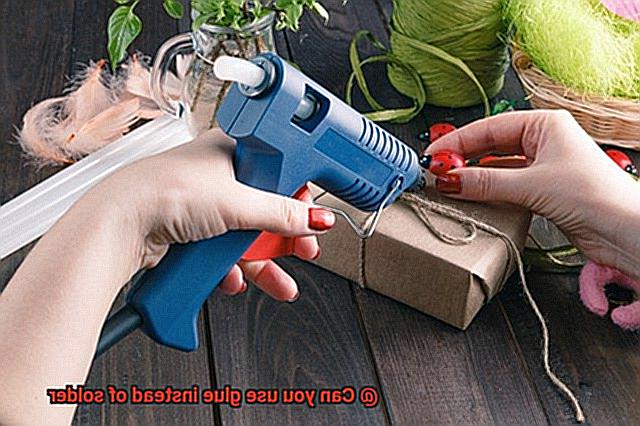
Soldered joints are the go-to solution when it comes to linking components and wires in electronic and electrical applications. But what exactly does the mechanical strength of a soldered joint entail? It refers to the joint’s ability to withstand an array of forces and stresses without succumbing to breakage or separation. It must be noted, however, that solder typically falls short in terms of mechanical strength when compared to welding or brazing. Nevertheless, solder remains suitable for myriad applications where the forces and stresses involved remain relatively low.
Now, let’s turn our attention to adhesive glues. These powerful substances can provide greater mechanical strength than solder in specific scenarios. The market offers a plethora of adhesive glues, each designed to bond various materials together seamlessly. Glue joints boast remarkable resistance to vibrations and mechanical loads, making them ideal for situations characterized by high mechanical stress or constant movement.
However, before you consider swapping solder for glue, certain factors must be taken into account. High temperatures can prove to be game-changers. Some adhesive glues may lose their strength or degrade when exposed to elevated temperatures, leading to joint failure. Therefore, if you find yourself working with soaring temperatures, solder might still be your best bet.
Additionally, the compatibility of the adhesive with the materials being bonded cannot be overlooked. Certain adhesives may struggle to form strong bonds with specific materials, resulting in weak joints or delamination. Thus, it is crucial to select the right adhesive for the job at hand.
In summary, while glue can offer superior mechanical strength in certain circumstances, temperature fluctuations, forces, stresses, and material compatibility must all be considered. Soldered joints remain the more prevalent choice in electronic and electrical applications due to their reliability and adaptability to a wide range of situations.
xqiJ7kjr1O4″ >
Conclusion
Using glue instead of solder may seem like a convenient alternative, but it is not recommended for several reasons.
Glue lacks the strength and conductivity that solder provides, making it unsuitable for many electronic and electrical applications. Additionally, glue may not withstand high temperatures or provide a secure bond over time.
It also has excellent thermal conductivity, which is crucial for dissipating heat in electronic devices.

